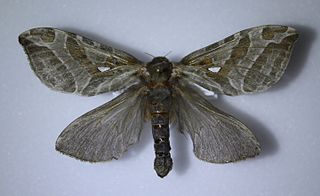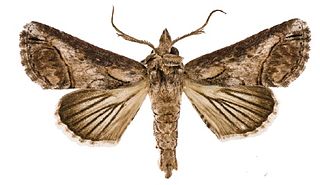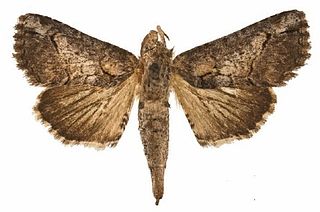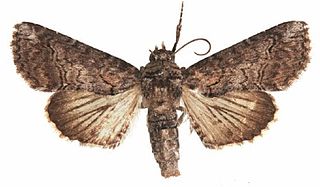
Enyo lugubris, the mournful sphinx, is a moth of the family Sphingidae. It is found from Argentina and Paraguay to Uruguay, Venezuela, Guyana, Suriname, French Guiana, Colombia, Ecuador, Peru, Brazil and the West Indies through Belize, Guatemala, Honduras, El Salvador, Nicaragua, Costa Rica and Panama to Mexico and the United States, where it has been recorded from Arizona east to Florida and north to South Carolina. Strays have been recorded from Arkansas, north to Illinois, Michigan and New York.

Paectes is a genus of moths of the family Euteliidae erected by Jacob Hübner in 1818.

Ectoedemia occultella, the small birch leafminer, is a moth of the family Nepticulidae. It has a Holarctic distribution. It is found in most of Europe, east through Russia to Japan. It is also present in North America. Mines very similar to that of Ectoedemia occultella have been found on Rosaceae species in Nepal and Japan and these may belong to this species.

The Erebidae are a family of moths in the superfamily Noctuoidea. The family is among the largest families of moths by species count and contains a wide variety of well-known macromoth groups. The family includes the underwings (Catocala); litter moths (Herminiinae); tiger, lichen, and wasp moths (Arctiinae); tussock moths (Lymantriinae), including the arctic woolly bear moth ; fruit-piercing moths ; micronoctuoid moths (Micronoctuini); snout moths (Hypeninae); and zales, though many of these common names can also refer to moths outside the Erebidae. Some of the erebid moths are called owlets.

Anatrachyntis rileyi, the pink cornworm, pink bud moth or pink scavenger, is a species of moth of the family Cosmopterigidae, the cosmet moths. It was first described by Lord Walsingham in 1882 from the southern United States, but it is probably an introduction to North America. It is found in much of the warm or tropical areas of the world, including northern Australia, the Galápagos Islands, Hawaii, the Antilles, South America and Mauritius.

Hellula rogatalis, the cabbage webworm, is a moth of the family Crambidae described by George Duryea Hulst in 1886. It is found from the southern United States north in the east to Maryland, New York and Ontario. It is also found in Mexico, where it has been recorded from Distrito Federal.

Paectes abrostoloides, the large paectes moth or sweetgum defoliator, is a moth of the family Euteliidae. The species was first described by Achille Guenée in 1852. It is found in the US from Massachusetts to Florida, west to Arizona and north to Utah. It has also been recorded from the Antilles and Honduras.

Paectes obrotunda is a moth of the family Euteliidae first described by Achille Guenée in 1852. It is found in Brazil. The species is only known from the female holotype. Formerly, the species was recorded from Southern North America through Central America to South America. It is also found on the Greater Antilles and Lesser Antilles. These records were based on misidentifications.

Sthenopis argenteomaculatus, the silver-spotted ghost moth, is a species of moth of the family Hepialidae. It was described by Thaddeus William Harris in 1841, and is known in North America from Nova Scotia to North Carolina and west to Minnesota.

Paectes arcigera is a moth in the family Euteliidae first described by Achille Guenée in 1852. It is restricted to the eastern Caribbean Islands, ranging from Puerto Rico to the Lesser Antilles.

Paectes similis is a moth in the family Euteliidae first described by Michael G. Pogue in 2013. It is found in the north-eastern Brazilian state of Pernambuco.

Paectes asper is a moth in the family Euteliidae first described by Michael G. Pogue in 2013. It is widespread from southern Florida and the Bahamas to the Greater Antilles, and the British Virgin Islands, U.S. Virgin Islands, and Dominica in the Lesser Antilles.

Paectes medialba is a moth in the family Euteliidae first described by Michael G. Pogue in 2013. It is found in north-western Argentina.

Paectes sinuosa is a moth in the family Euteliidae first described by Michael G. Pogue in 2013. It is found in the Brazilian states of Goiás and São Paulo, north-western Paraguay and the Argentine province of Tucumán.

Paectes tumida is a moth in the family Euteliidae first described by Michael G. Pogue in 2013. It is found in Colombia (Villavicencio), Guyana, Suriname and French Guiana.
Haplochrois galapagosalis is a moth in the family Elachistidae. It was described by Bernard Landry in 2001. It is found on the Galápagos Islands.

Phyllodonta intermediata is a moth in the family Geometridae first described by J. Bolling Sullivan in 2014. It is found in the Talamancas and Central Volcanic and Tilarán ranges in Costa Rica, possibly extending into the other Costa Rican mountain ranges and northern Panama. It has been recorded from elevations between 1,275 and 2,280 meters.

Circanota undulata is a species of moth of the family Tortricidae. It is found in Costa Rica and Panama, at altitudes below about 900 meters.
Dichomeris hortulana is a moth in the family Gelechiidae. It was described by Edward Meyrick in 1918. It is found in India, South Africa, the Seychelles, where it has been recorded from Silhouette and Mahé as well as Mauritius and Mayotte.
Amphixystis fragosa is a moth of the family Tineidae. This species is known from Mauritius and Réunion. On Réunion, adults are on wing year-round.
















